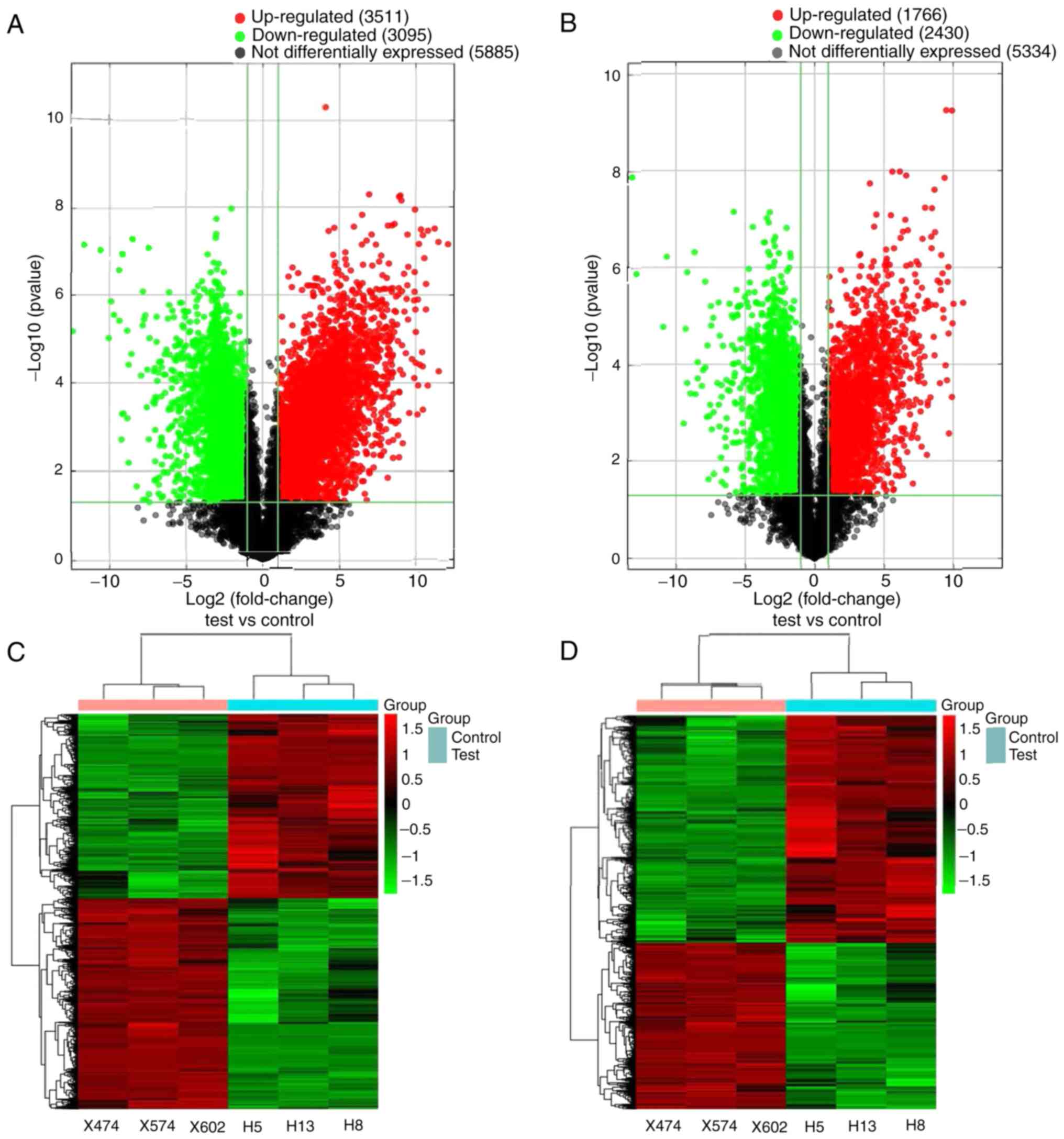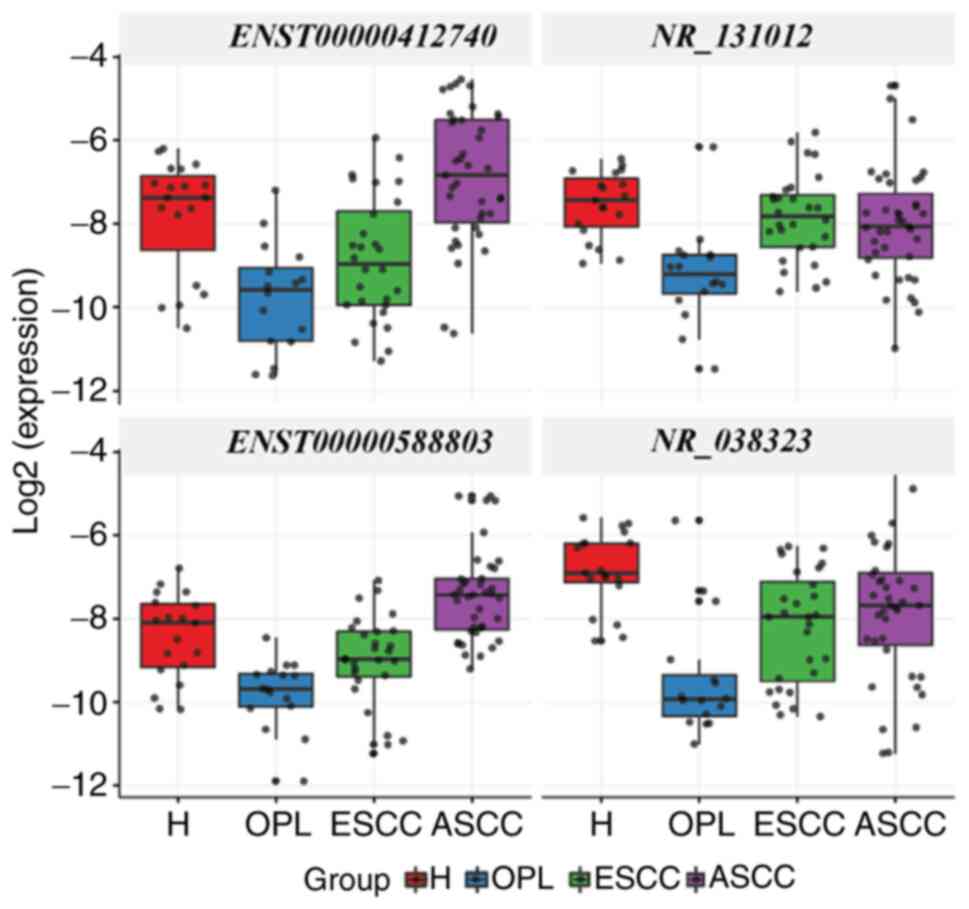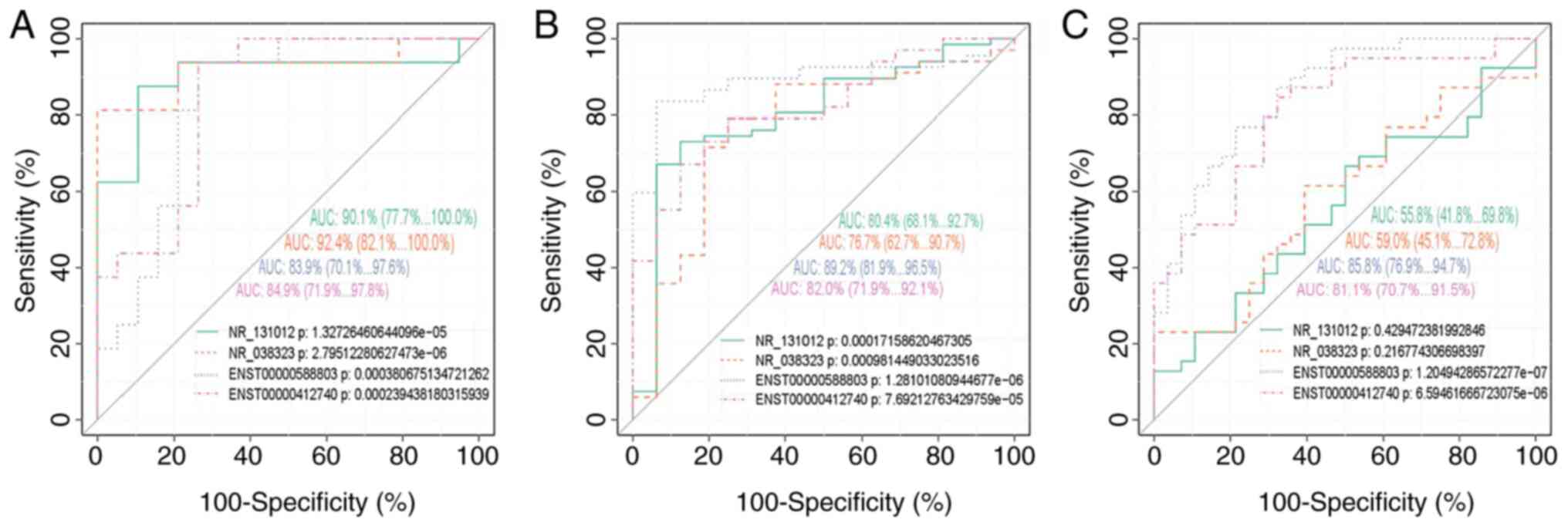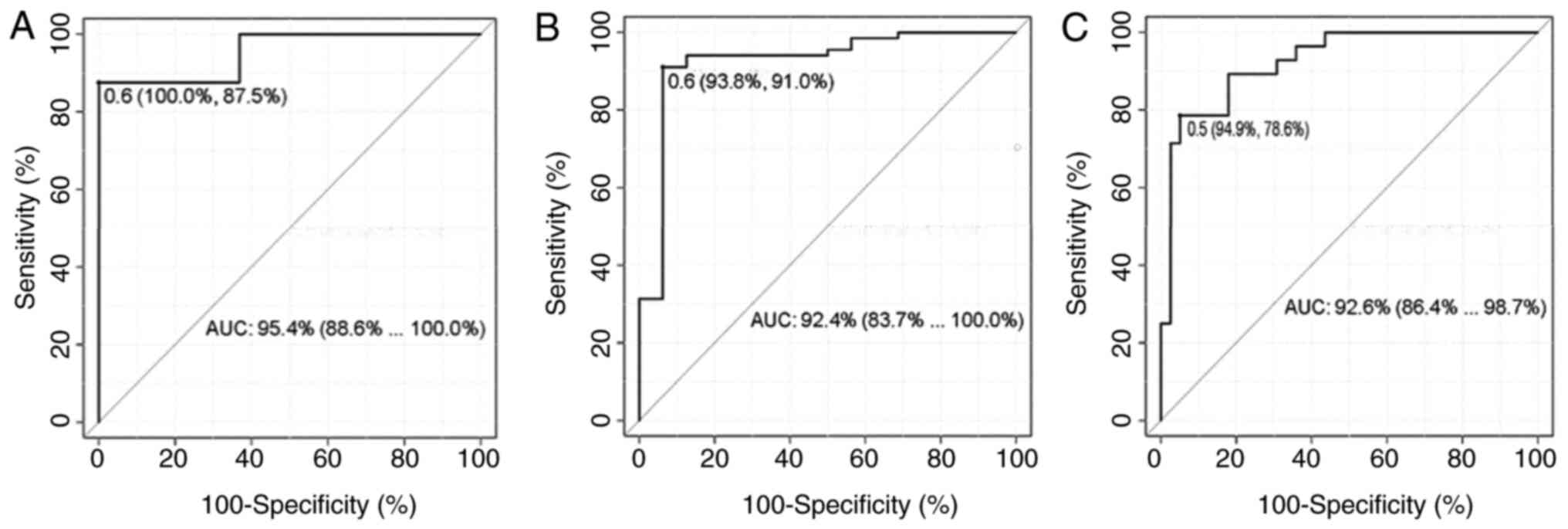|
1
|
Gupta B, Johnson NW and Kumar N: Global
epidemiology of head and neck cancers: A continuing challenge.
Oncology. 91:13–23. 2016. View Article : Google Scholar : PubMed/NCBI
|
|
2
|
Bray F, Ferlay J, Soerjomataram I, Siegel
RL, Torre LA and Jemal A: Global cancer statistics 2018: GLOBOCAN
estimates of incidence and mortality worldwide for 36 cancers in
185 countries. CA Cancer J Clin. 68:394–424. 2018. View Article : Google Scholar : PubMed/NCBI
|
|
3
|
Sinevici N and O'sullivan J: Oral cancer:
Deregulated molecular events and their use as biomarkers. Oral
Oncol. 61:12–18. 2016. View Article : Google Scholar : PubMed/NCBI
|
|
4
|
Ghani WMN, Ramanathan A, Prime SS, Yang
YH, Razak IA, Abdul Rahman ZA, Abraham MT, Mustafa WMW, Tay KK,
Kallarakkal TG, et al: Survival of oral cancer patients in
different ethnicities. Cancer Invest. 37:275–287. 2019. View Article : Google Scholar : PubMed/NCBI
|
|
5
|
Alonso JE, Han AY, Kuan EC, Strohl M, Clai
JM, St John MA, Ryan WR and Heaton CM: The survival impact of
surgical therapy in squamous cell carcinoma of the hard palate.
Laryngoscope. 128:2050–2055. 2018. View Article : Google Scholar : PubMed/NCBI
|
|
6
|
Bloebaum M, Poort L, Bockmann R and
Kessler P: Survival after curative surgical treatment for primary
oral squamous cell carcinoma. J Craniomaxillofac Surg.
42:1572–1576. 2014. View Article : Google Scholar : PubMed/NCBI
|
|
7
|
Quinn JJ and Chang HY: Unique features of
long non-coding RNA biogenesis and function. Nat Rev Genet.
17:47–62. 2016. View Article : Google Scholar : PubMed/NCBI
|
|
8
|
Kornienk AE, Guenzl PM, Barlow DP and
Pauler FM: Gene regulation by the act of long non-coding RNA
transcription. BMC Biol. 11:592013. View Article : Google Scholar : PubMed/NCBI
|
|
9
|
Geisler S and Coller J: RNA in unexpected
places: Long non-coding RNA functions in diverse cellular contexts.
Nat Rev Mol Cell Biol. 14:699–712. 2013. View Article : Google Scholar : PubMed/NCBI
|
|
10
|
Wapinski O and Chang HY: Long noncoding
RNAs and human disease. Trends Cell Biol. 21:354–361. 2011.
View Article : Google Scholar : PubMed/NCBI
|
|
11
|
Lalevee S and Fei R: Long noncoding RNAs
in human disease: Emerging mechanisms and therapeutic strategies.
Epigenomics. 7:877–879. 2015. View Article : Google Scholar : PubMed/NCBI
|
|
12
|
Chandra Gupta S and Nandan Tripathi Y:
Potential of long non-coding RNAs in cancer patients: From
biomarkers to therapeutic targets. Int J Cancer. 140:1955–1967.
2017. View Article : Google Scholar : PubMed/NCBI
|
|
13
|
Zhang L, Meng X, Zhu XW, Yang DC, Chen R,
Jiang Y and Xu T: Long non-coding RNAs in Oral squamous cell
carcinoma: Biologic function, mechanisms and clinical implications.
Mol Cancer. 18:1022019. View Article : Google Scholar : PubMed/NCBI
|
|
14
|
Ren S, Wang F, Shen J, Sun Y, Xu W, Lu J,
Wei M, Xu C, Wu C, Zhang Z, et al: Long non-coding RNA metastasis
associated in 1ung adenocarcinoma transcript l derived miniRNA as a
novel plasma-based biomarker for diagnosing prostate cancer. Eur J
Cancer. 49:2949–2959. 2013. View Article : Google Scholar : PubMed/NCBI
|
|
15
|
Kogo R, Shimamura T, Mimori K, Kawahara K,
Imoto S, Sudo T, Tanaka F, Shibata K, Suzuki A, Komune S, et al:
Long noncoding RNA HOTAIR regulates polycomb-dependent chromatin
modification and is associated with poor prognosis in colorectal
cancers. Cancer Res. 71:6320–6326. 2011. View Article : Google Scholar : PubMed/NCBI
|
|
16
|
Sun M, Jin FY, Xia R, Kong R, Li JH, Xu
TP, Liu YW, Zhang EB, Liu XH and De W: Decreased expression of long
noncoding RNA GAS5 indicates a poor prognosis and promotes cell
proliferation in gastric cancer. BMC Cancer. 14:3192014. View Article : Google Scholar : PubMed/NCBI
|
|
17
|
Gibb EA, Enfield KS, Stewart GL, Lonergan
KM, Chari R, Ng RT, Zhang L, MacAulay CE, Rosin MP and Lam WL: Long
non-coding RNAs are expressed in oral mucosa and altered in oral
premalignant lesions. Oral Oncol. 47:1055–1061. 2011. View Article : Google Scholar : PubMed/NCBI
|
|
18
|
Tang H, Wu Z, Zhang J and Su B: Salivary
lncRNA as a potential marker for oral squamous cell carcinoma
diagnosis. Mol Med Rep. 7:761–766. 2013. View Article : Google Scholar : PubMed/NCBI
|
|
19
|
Fang Z, Wu L, Wang L, Yang Y, Meng Y and
Yang HL: Increased expression of the long non-coding RNA UCA1 in
tongue squamous cell carcinomas: A possible correlation with cancer
metastasis. Oral Surg Oral Med Oral Pathol Oral Radiol. 117:89–95.
2014. View Article : Google Scholar : PubMed/NCBI
|
|
20
|
Jia H, Wang X and Sun Z: Exploring the
long noncoding RNAs-based biomarkers and pathogenesis of malignant
transformation from dysplasia to oral squamous cell carcinoma by
bioinformatics method. Eur J Cancer Prev. 29:174–181. 2020.
View Article : Google Scholar : PubMed/NCBI
|
|
21
|
Jia H, Wang X and Sun Z: Exploring the
molecular pathogenesis and biomarkers of high risk oral
premalignant lesions on the basis of long noncoding RNA expression
profiling by serial analysis of gene expression. Eur J Cancer Prev.
27:370–378. 2018. View Article : Google Scholar : PubMed/NCBI
|
|
22
|
Livak KJ and Schmittgen TD: Analysis of
relative gene expression data using real-time quantitative PCR and
the 2(-Delta Delta C(T)) method. Methods. 25:402–408. 2001.
View Article : Google Scholar : PubMed/NCBI
|
|
23
|
Shao T, Huang J, Zheng Z, Wu Q, Liu T and
Lv X: SCCA, TSGF, and the long non-coding RNA AC007271.3 are
effective biomarkers for diagnosing oral squamous cell carcinoma.
Cell Physiol Biochem. 47:26–38. 2018. View Article : Google Scholar : PubMed/NCBI
|
|
24
|
Sciubba JJ: Oral cancer: The importance of
early diagnosis and treatment. Am J Clin Dermalol. 2:239–251. 2001.
View Article : Google Scholar
|
|
25
|
Meseure D, Drak Alsibai K, Nicolas A,
Bieche I and Morillon A: Long noncoding RNAs as architects in
cancer epigenetics, prognostic biomarkers, and potential
therapeutic targets. Biomed Res Int. 2015:3202142015. View Article : Google Scholar : PubMed/NCBI
|
|
26
|
Kladi-Skandali A, Michaelidou K, Scorilas
A and Mavridis K: Long noncoding rnas in digestive system
malignancies: A novel class of cancer biomarkers and therapeutic
targets? Gastroenterol Res Pract. 2015:3198612015. View Article : Google Scholar : PubMed/NCBI
|
|
27
|
Fatima R, Akhade VS, Pal D and Rao SM:
Long noncoding RNAs in development and cancer: Potential biomarkers
and therapeutic targets. Mol Cell Ther. 3:52015. View Article : Google Scholar : PubMed/NCBI
|
|
28
|
Tang Q, Ni Z, Cheng Z, Xu J, Yu H and Yin
P: Three circulating long non-coding RNAs act as biomarkers for
predicting NSCLC. Cell Physiol Biochem. 37:1002–1009. 2015.
View Article : Google Scholar : PubMed/NCBI
|
|
29
|
Li J, Wang X, Tang J, Jiang R, Zhang W, Ji
J and Sun B: HULC and Linc00152 act as novel biomarkers in
predicting diagnosis of hepatocellular carcinoma. Cell Physiol
Biochem. 37:687–696. 2015. View Article : Google Scholar : PubMed/NCBI
|
|
30
|
Ge Q, Zhou Y, Lu J, Bai Y, Xie X and Lu Z:
miRNA in plasma exosome is stable under different storage
conditions. Molecules. 19:1568–1575. 2014. View Article : Google Scholar : PubMed/NCBI
|
|
31
|
Tsui NB, Ng EK and Lo YM: Stability of
endogenous and added RNA in blood specimens, serum, and plasma.
Clin Chem. 48:1647–1653. 2002. View Article : Google Scholar : PubMed/NCBI
|
|
32
|
Schlosser K, Hanson K, Villeneuve PK,
Dimitroulakos J, McIntyre L, Pilote L and Stewart DJ: Assessment of
circulating LncRNAs under physiologic and pathologic conditions in
humans reveals potential limitations as biomarkers. Sci Rep.
6:365962016. View Article : Google Scholar : PubMed/NCBI
|
|
33
|
Mercer TR, Gerhardt DJ, Dinger ME,
Crawford J, Trapnell C, Jeddeloh JA, Mattick JS and Rinn JL:
Targeted RNA sequencing reveals the deep complexity of the human
transcriptome. Nat Biotechnol. 30:99–104. 2011. View Article : Google Scholar : PubMed/NCBI
|
|
34
|
Prensner JR, Iyer MK, Sahu A, Asangani IA,
Cao Q, Patel L, Vergara IA, Davicioni E, Erho N, Ghadessi M, et al:
The long noncoding RNA SChLAPI promotes aggressive prostate cancer
and antagonizes the SWI/SNF complex. Nat Genet. 45:1392–1298. 2013.
View Article : Google Scholar : PubMed/NCBI
|
|
35
|
Kurokawa H, Yamashita Y, Tokudome S and
Kajiyama M: Combination assay for tumor markers in oral squamous
cell carcinoma. J Oral Maxillofac Surg. 55:964–966. 1997.
View Article : Google Scholar : PubMed/NCBI
|
|
36
|
Clemson CM, Hutchinson JN, Sara SA,
Ensminger AW, Fox AH, Chess A and Lawrence JB: An architectural
role for a nuclear noncoding RNA: NEAT1 RNA is essential for the
structure of paraspeckles. Mol cell. 33:717–726. 2009. View Article : Google Scholar : PubMed/NCBI
|
|
37
|
Leemans CR, Braakhuis BJ and Brakenhoff
RH: The molecular biology of head and neck cancer. Nat Rev Cancer.
11:9–22. 2011. View Article : Google Scholar : PubMed/NCBI
|
|
38
|
Smeets SJ, van der Plas M, Schaaij-Visser
TB, van Veen EA, van Meerloo J, Braakhuis BJ, Steenbergen RD and
Brakenhoff RH: Immortalization of oral keratinocytes by functional
inactivation of the p53 and pRb pathways. Int J Cancer.
128:1596–1605. 2011. View Article : Google Scholar : PubMed/NCBI
|
|
39
|
Graveland AP, Bremmer JF, de Maaker M,
Brink A, Cobussen P, Zwart M, Braakhuis BJ, Bloemena E, van der
Waal I, Leemans CR and Brakenhoff RH: Molecular screening of oral
precancer. Oral Oncol. 49:1129–1135. 2013. View Article : Google Scholar : PubMed/NCBI
|
|
40
|
Adriaens C, Standaert L, Barra J, Latil M,
Verfaillie A, Kalev P, Boeckx B, Wijinhoven PW, Radaelli E, Vermi
W, et al: p53 induces formation of NEAT1 lncRNA-containing
paraspeckles that modulate replication stress response and
chemosensitivity. Nat Med. 22:861–868. 2016. View Article : Google Scholar : PubMed/NCBI
|
|
41
|
Fang J, Qiao F, Tu J, Xu J, Ding F, Liu Y,
Akuo BA, Hu J and Shao S: High expression of long non-coding RNA
NEAT1 indicates poor prognosis of human cancer. Oncotarget.
8:45918–45927. 2017. View Article : Google Scholar : PubMed/NCBI
|


















